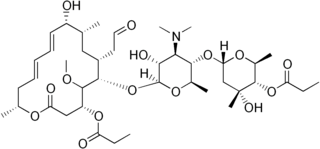Related Research Articles

Streptomyces is the largest genus of Actinobacteria and the type genus of the family Streptomycetaceae. Over 500 species of Streptomyces bacteria have been described. As with the other Actinobacteria, streptomycetes are gram-positive, and have genomes with high GC content. Found predominantly in soil and decaying vegetation, most streptomycetes produce spores, and are noted for their distinct "earthy" odor that results from production of a volatile metabolite, geosmin.

Midecamycin is a macrolide antibiotic that is synthesized from Streptomyces mycarofaciens.
Venturicidins are a group of antifungal compounds. The first member of this class was isolated from Streptomyces bacteria in 1961. Additional members of this class were subsequently isolated and characterized. An antifungal substance "aabomycin A" was isolated from Streptomyces in 1969. However, in 1990 it was reported that aabomycin A is actually a 3:1 mixture of two related components, which were then named aabomycin A1 and aabomycin A2. The structures of these were shown to be identical with those of the previously characterized compounds venturicidin A and venturicidin B, respectively. A new analog, venturicidin C, was recently reported from a Streptomyces isolated from thermal vents associated with the Ruth Mullins coal fire in Kentucky.
The Center for Pharmaceutical Research and Innovation (CPRI) is a University of Kentucky-based research center established by the University of Kentucky College of Pharmacy in 2012 to facilitate academic translational research and drug discovery/drug development. The UK CPRI specializes in natural product-based drug discovery from microbes found within unique environments including underground and surface coal mines, acid mine drainage and mine reclamation sites, thermal vents associated with underground coal mine fires and deep-well drilling for carbon sequestration. CPRI also provides core support for medicinal chemistry, assay development and screening, rational drug design, computational chemistry, and ADMET. The Center collaborates with investigators focused on drug discovery or development research in the areas of cancer, drug and alcohol addiction, cardiovascular disease, infectious disease, regenerative medicine and neurodegenerative disease.
Streptomyces alboflavus is a bacterium species from the genus of Streptomyces which produces oxytetracycline, tetracycline and desertomycin A.
Streptomyces canus is a bacterium species from the genus of Streptomyces which has been isolated from soil in the US. Streptomyces canus produces resistomycin, tetracenomycin D, amphomycin, aspartocin D and aspartocin E.
Streptomyces cavourensis is a bacterium species from the genus of Streptomyces which has been isolated from soil in Italy. Streptomyces cavourensis produces flavensomycin.
Streptomyces chattanoogensis is a bacterium species from the genus of Streptomyces which has been isolated from soil in Tennessee in the United States. Streptomyces chattanoogensis produces natamycin, pimaricin and tennecetin.
Streptomyces diastaticus is an alkaliphilic and thermophilic bacterium species from the genus of Streptomyces. Streptomyces diastaticus produces oligomycin A, oligomycin C, rimocidin and the leukotriene-A4 hydrolase-inhibitor 8(S)-amino-2(R)-methyl-7-oxononanoic acid. Streptomyces diastaticus also produces gougerotin and the antibiotic ruticin.
Streptomyces durhamensis is a bacterium species from the genus of Streptomyces which has been isolated from soil from a tomato plant. Streptomyces durhamensis produces durhamycin and filipin.
Streptomyces actuosus is a bacterium species from the genus of Streptomyces. Streptomyces actuosus produces nosiheptide and staurosporin.
Streptomyces graminearus is a bacterium species from the genus of Streptomyces. Streptomyces graminearus produces the antibiotic gougerotin.
Streptomyces halstedii is a bacterium species from the genus of Streptomyces which has been isolated from deeper soil layers. Streptomyces halstedii produces magnamycin B, vicenistatin deltamycin A2, deltamycin A3, bafilomycin B1 and bafilomycin C1. Streptomyces halstedii also produces complex antifungal antibiotics like oligomycins and the antibiotics anisomycin and sinefungin.
Streptomyces hundungensis is a bacterium species from the genus of Streptomyces which has been isolated from a quarry in Tangkhul Hundung in Manipur in India Streptomyces hundungensis has antifungal activity.
Streptomyces lydicus is a bacterium species from the genus of Streptomyces which has been isolated from soil in the United States. Streptomyces lydicus produces actithiazic acid, natamycin, lydimycin, streptolydigin, and 1-deoxygalactonojirimycin. Streptomyces lydicus can be used as an agent against fungal plant pathogens like Fusarium, Pythium, Phytophthora, Rhizoctonia and Verticillum.
Streptomyces microflavus is a bacterium species from the genus of Streptomyces which has been isolated from soil. Streptomyces microflavus produces nemadectin, fattiviracin A1, milbemycin and deoxyuridines. Streptomyces microflavus also produces the ionophore valinomycin. Streptomyces microflavus is also known to cause potato common scab disease in Korea.
Streptomyces phytohabitans is a bacterium species from the genus of Streptomyces which has been isolated from the plant Curcuma phaeocaulis from the Sichuan Province in China. Streptomyces phytohabitans produces the macrolides novonestmycin A and novonestmycin B.
Streptomyces varsoviensis is a bacterium species from the genus of Streptomyces which has been isolated from soil. Streptomyces varsoviensis produces oxytetracycline and hygrobafilomycin.
Streptomyces violaceusniger is a bacterium species from the genus of Streptomyces. Streptomyces violaceusniger has antifungal activity. Streptomyces violaceusniger produces isoafricanol and spirofungin.
Nocardiopsis is a bacterial genus from the family of Nocardiopsaceae which can produces some antimicrobial compounds, including thiopeptides. Nocardiopsis occur mostly in saline and alkaline soils.
References
- 1 2 LPSN bacterio.net
- ↑ Straininfo of Streptomyces flavotricini
- 1 2 UniProt
- ↑ Deutsche Sammlung von Mikroorganismen und Zellkulturen
- ↑ ATCC
- ↑ Zhang, DJ; Wei, G; Wang, Y; Si, CC; Tian, L; Tao, LM; Li, YG (May 2011). "Bafilomycin K, a new antifungal macrolide from Streptomyces flavotricini Y12-26". The Journal of Antibiotics. 64 (5): 391–3. doi: 10.1038/ja.2011.12 . PMID 21386849.